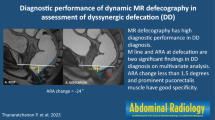Abstract
Purpose
The sigmoidorectal junction (SRJ) has been defined as an anatomical sphincter with particular physiological behavior that regulates sigmoid and rectum evacuation. Its function in clinical conditions, such as diverticular disease has been advocated. The aim of our study is to identify the SRJ and to compare the morphometric and dynamic features of the SRJ between patients with diverticular disease and healthy subjects using MR-defecography.
Methods
Sixteen individuals, eight with uncomplicated diverticular disease and eight healthy subjects, were studied using MR-defecography to identify the SRJ and to compare the morphometric and dynamic features observed.
Results
In each subject studied, MR-defecography was able to identify the SRJ. This resulted in the identification of a discrete anatomical entity with a mean length of 31.23 mm, located in front of the first sacral vertebra (S1) and at a mean distance of 15.55 cm from the anal verge, with a mean wall thickness of 4.45 mm, significantly different from the sigmoid and rectal parietal thickness. The SRJ wall was significantly thicker in patients with diverticular disease than the controls (P = 0.005), showing a unique shape and behavior in dynamic sequences.
Conclusion
Our findings support the hypothesis that SRJ plays a critical role in patients with symptomatic diverticular disease; further investigation may clarify whether specific SRJ analysis, such as MR-defecography, would predict inflammatory complications of this diffuse and heterogenic disease.



Similar content being viewed by others
References
Cantlie J (1915) The sigmoid flexure in health and disease. J Trop Med Hyg 18:1–7
Carpenter JG (1898) The physiology of the colon, sigmoid and rectum. JAMA 30:424–426
Colaiacomo MC, Masselli G, Polettini E, Lanciotti S, Casciani E, Bertini L, Gualdi G (2009) Dynamic MR imaging of the pelvic floor: a pictorial review. Radiographics 3:e35 Epub 2009 Mar 6
Connell AM (1975) Applied physiology of the colon. Factors relevant to diverticular disease. Clin Gastroenterol 4:23–36
Connel AM (1977) Pathogenesis of diverticular disease of the colon. Adv Intern Med 22:377–395
Gordon PH (2007) Principles and practice of surgery for colon, rectum, anus. In: 3rd edn. 918
He JH, Wang Q, Cai QP, Dang RS, Jiang EP, Huang HL, Sun YP (2010) Quantitative anatomical study of male pelvic autonomic plexus and its clinical potential in rectal resection. Surg Radiol Anat 32:783–790
Hyrtl J (1860) Handbuch der topographischen anatomie und ihrer praktisch medicinisch-chirurgischen anwendungen. II
Jin ZM, Peng JY, Zhu QC, Yin L (2011) Waldeyer’s fascia: anatomical location and relationship to neighboring fasciae in retrorectal space. Surg Radiol Anat 33:851–854
Mayo WJ (1917) A study of the rectosigmoid. Surg Gynecol Obstet 25:616–621
Mann CV (1979) Problems in diverticular disease. Proctology 1:20–25
O’ Beirne J (1833) The new views of the process of defecation and their application to the pathology and treatment of disease of stomach bowel and other organs
Parks TG (1975) Natural history of diverticular disease of the colon. Clin Gastroenterol 4:53–69
Pirro N, Pignodel C, Cathala P, Fabbro-Peray P, Godlewski G, Prudhomme M (2008) The number of lymph nodes is correlated with mesorectal morphometry. Surg Radiol Anat 30:297–302
Plattner V, Leborgne J, Heloury Y, Cohen JY, Rogez JM, Lehur PA, Robert R (1991) MRI evaluation of the levetor ani muscle: anatomic correlations and practical application. Surg Radiol Anat 13:129–131
Shafik A, El-Sibai O, Ahmed I (2001) Role of the sigmoid colon in the defecation mechanism with evidence of sigmoido-anal inhibitory and ano-sigmoid excitatory reflex. Front Biosci 6:b25–b29
Shafik A, El-Sibai O, Mostafa RM, Shafik I (2001) Study of the mechanism of rectal motility: the “Mass Squeeze Contraction”. Arch Phisiol Biochem 109:418–423
Shafik A, Shafik AA, El-Sibai O, Ali YA (2003) Videodefecography: a study of the rectal motile pattern. Surg Radiol Anat 25:139–144
Shafik A, Asaad S, Doss S (2003) Identification of a sphincter at the sigmoidorectal canal in humans: histomorphologic and morphometric studies. Clin Anat 16:138–143
Shafik A, Shafik A, El-Sibai O, Ahmed I, Mostafa RM (2006) Role of rectosigmoidal junction in fecal continence. Arch Surg 141:23–26
Simpson J, Scholefield JH, Spiller RC (2003) Origin of symptoms in diverticular disease. Brit J Surg 90:899–908
Stoss F (1990) Investigations of the muscular architecture of the rectosigmoid juction in Humans. Dis Colon Rectum 33:378–383
Thaler K, Baig M, Berho M et al (2003) Determinants of recurrence after sigmoid colon resection for uncomplicated diverticulitis. Dis Colon Rectum 46:385–388
Wadhawa RP, Mistry FP, Bathia SJ, Abraham P (1996) Existence of a High pressure zone at rectosigmoid junction in normal Indian men. Dis Colon Rectum 39:1122–1125
Weinreich J, Andersen D (1976) Intraluminal pressure in sigmoid colon II. Patients with sigmoid diverticula and related conditions. Scand J Gastroenterol 11:581–586
Wu Y, Zhang SX, Luo N, Qiu MG, Tan LW, Li QY, Liu GJ, Li K (2010) Creation of the digital three-dimensional model of the prostate and its adjacent structures based on Chinese visibile human. Surg Radiol Anat 32:629–635
Acknowledgments
We acknowledge Drs. Nathasha Marasco and Hugh Holt (London, UK) for their assistance in manuscript preparation and proof reading.
Conflict of interest
Authors declare that there have no conflicts of interest in this manuscript.
Ethical standard statement
The authors ensure that any experimental investigation reported in the manuscript was performed with informed consent and following all the guidelines for experimental investigation with human subjects required by the institutions with which all the authors are affiliated and in according with the current law of the country in which the research was performed.
Author information
Authors and Affiliations
Corresponding author
Rights and permissions
About this article
Cite this article
Romagnoli, F., Colaiacomo, M.C., De Milito, R. et al. The alterations of the sigmoid-rectal junction in diverticular disease of the colon revealed by MR-defecography. Surg Radiol Anat 36, 85–90 (2014). https://doi.org/10.1007/s00276-013-1133-1
Received:
Accepted:
Published:
Issue Date:
DOI: https://doi.org/10.1007/s00276-013-1133-1




